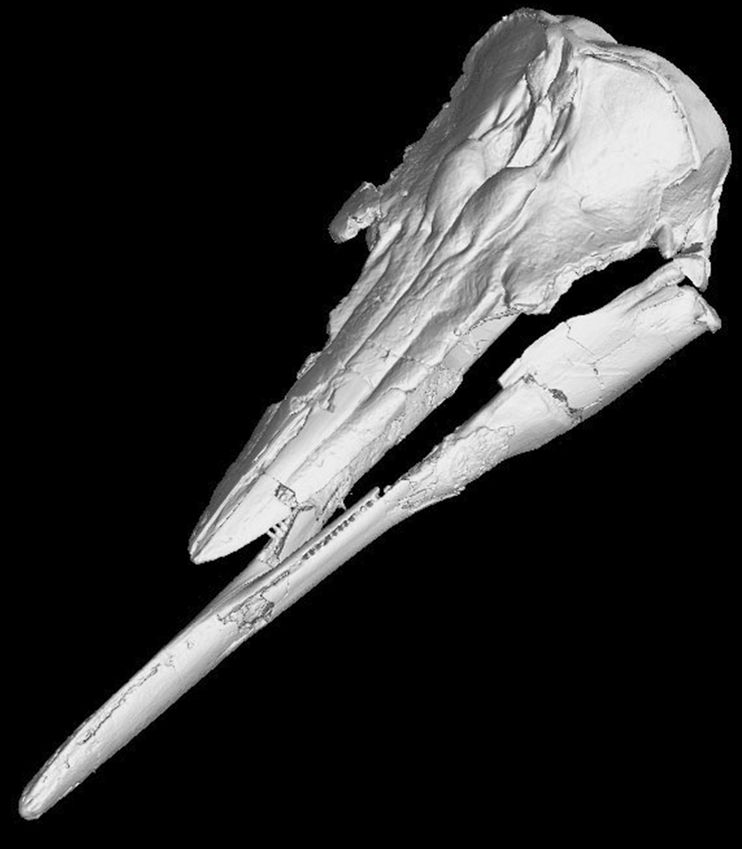Talk about a jaw-dropping specimen: An extinct California porpoise was found to have a lower jaw extending well beyond the upper, the first known example of a mammal with a big underbite.
The fossilized porpoise, which lived 1.6 to 5 million years ago, had been part of the San Diego Natural History Museum‘s collection for years. But it was only when Yale University paleontologist Rachel Racicot ran CT scans on it that scientists discovered they had a new, big-chinned species on its hands.
“This underbite is huge, and a huge structure like that demands a special explanation,” said Ewan Fordyce, a paleontologist at the University of Otago, New Zealand.
The researchers’ findings were published in the March 13 issue of Current Biology.
While other porpoises, dolphins, and whales can have an underbite, it’s generally quite small.
Racicot’s analysis suggested that the extinct porpoise, known as a skimmer porpoise (Semirostrum ceruttii), may have used its lower jaw to probe the seafloor for prey.
Fordyce, who was not involved in the study, said the find “adds significantly to our understanding of geologically young but recently extinct dolphins and porpoises.”

Clues From Birds and Fish
Racicot’s first clue about a reason for the porpoise’s unusual jaw structure emerged unexpectedly, from her bird-watching habit.
“When I first saw the jaw, I noticed that it was like that of a black skimmer,” she said, referring to a kind of seabird that has an underbite. Black skimmers fly low over the water with their extended lower jaws partially submerged, skimming for prey. (See photos of waterbirds.)
Racicot wondered if the extinct porpoise might be doing something similar, but while swimming at the bottom of the ocean.
“There were probably a lot of animals they could eat on the seafloor, so I imagine that they were sort of waving their head around, with their jaw a little bit in the sediment, feeling around for all kinds of food,” she said.
The CT scans she analyzed showed that the animal’s skull had similar tooth wear to that seen in black skimmers and other dolphin species that feed off the seafloor.
The lower jaw also contained long canals, which typically serve as conduits for nerves and blood supply and are similar to those found in black skimmers and half-beaks, a kind of fish.
“Once I saw those I was excited because I know that black skimmers have them, so it suggests a similar sensory function for the lower jaw,” Racicot said.
Like black skimmers and half-beaks, the extinct porpoises may have used their lower jaws to feel around for food under low-light conditions.
“I also saw that the optic canals are really small, which kind of implies that it maybe wasn’t using its eyesight as much as modern porpoises do,” Racicot said.
Seafloor Specialists
Many modern porpoises and dolphins tend to find prey down near the seafloor, but the difference is they’re not specialized for feeding there, Racicot said. (Read about harbor porpoises.)
The extinct porpoise comes from a time when there was a lot more species diversity, and possibly many more marine mammals feeding from the ocean floor.
“Maybe there was just a lot of food to eat at the seafloor, and there were a lot of different species that were specializing for that,” Racicot said. (Related: “Harbor Porpoises: Swimming to Safety.”)
The University of Otago’s Fordyce said the survival of other porpoises raises the question of why the one with the pronounced underbite disappeared, “whether it was something about the habitat that changed or possibly some competitor.
“I’m sure that now that this has been named and described, people will be looking out for it elsewhere,” he said. “I would expect that as more work is done, it might be possible to find more of this style of animal.”







